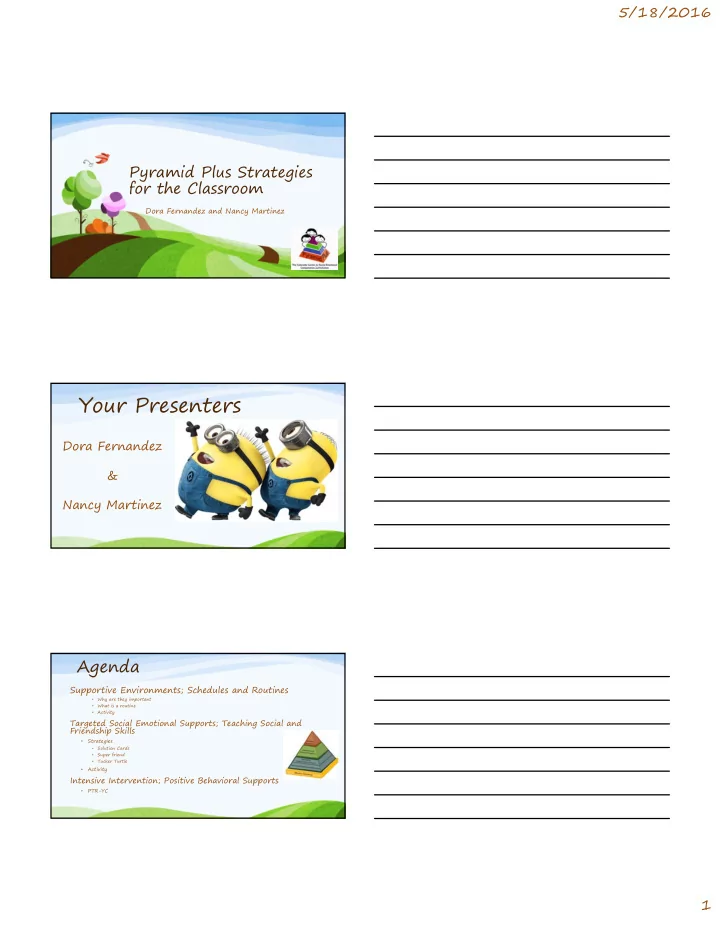

5/18/2016 Pyramid Plus Strategies for the Classroom Dora Fernandez and Nancy Martinez Your Presenters Dora Fernandez & Nancy Martinez Agenda Supportive Environments; Schedules and Routines Why are they important • What is a routine • Activity • Targeted Social Emotional Supports; Teaching Social and Friendship Skills Strategies • Solution Cards • Super friend • Tucker Turtle • Activity • Intensive Intervention; Positive Behavioral Supports PTR-YC • 1
5/18/2016 Supportive Environments: Schedules and Routines Why do Routines and Schedules Support Social Emotional Development? They meet the child’s basic needs • They are an important part of each day • They occur many times each day • They provide opportunities to interact • They stimulate learning • They provide predictability • They provide opportunities for self help skills • They help develop a sense of security and control • They support competence and confidence • They occur at home, center, and community • What is a routine Beginning and ending • Outcome oriented • Meaningful • Predictable • Sequential or systematic • Repetitious • 2
5/18/2016 Routines within routines within routines • Plan and determine the sequence in each daily activity. Maintain predictability and consistency to help promote • independence. • Collaborate and communicate with co-workers, families, and other professionals who participate in the learning environment. Be sure that all understand and know the sequence of the routines. Reinforce children for following through with the outlines • and participating in scheduled activities. https://youtu.be/utdllLBEHYs Routines within Routines within Routines Activity Routine within Routine • Pick a routine Sample LEAP Schedules and Routines Complete the routine within • the routine worksheet Arrival • Circle Time • Reminder a Routine has a • Centers • Beginning and ending • Story Time • Outcome oriented • Bathroom/Snack • • Meaningful Small Groups • • Predictable Outside Play • • Sequential or systematic Motor and Movement • • Good-bye • Repetitious 3
5/18/2016 Handouts and Resources • Helping children understand routines and classroom schedules. • Tips and Ideas for making visual supports • Supportive Environments; Schedules and Routines (Handout 8.8) • Positive comments within routines • http://csefel.vanderbilt.edu/resources/what_works.html Targeted Social Emotional Supports; Teaching Social and Friendship Skills Research and Findings • As many as 10% of all children show social skills impairment or delays that could lead to peer rejection. (Ashner, 1990) • Early peer relationship difficulties predict later disturbances. Specifically, peer rejection, aggression, withdrawal from school, certain forms of criminality, and possible mental health problems. (Kupersmidt et al, 1990) • When aggressive and antisocial behavior has persisted to age 9, further intervention has a poor chance of success. (Dodge, 1993) 4
5/18/2016 When to Teach the Skill Teach the whole class • Circle time • Centers • Small group activities • Partnering with families Target the individual skill instruction needs of each child • Embedded instruction (e.g. social stories) • Prompting and priming • Partnering with families Social skill: Problem Solving • Solution Cards • Make your own for your classroom or down load from http://csefel.vanderbilt.edu/resources/stra tegies.html#teachingskills I can be a “Super friend” http://csefel.vanderbilt.edu/resources /strategies.html#teachingskills 5
5/18/2016 Social Story: Tucker Turtle Activity: Embedded Friendship Opportunities into Daily Routines and Activities (all children) 1. Review your schedule and daily routines from previous activity 2. During routine, create one planned opportunity for social interaction & friendship skills for all children 3. Intentionally include peer to peer interactions. Session 8 Activity Activity Example: Embedded opportunities • Schedule Time Embedded and Intentional Teaching • Circle @8:30 am of Social and Friendship Skills • Activity • Two children pass out props to the • Arousing other children in the group. One child holds the basket, while the • Directed other child uses “Touch and Talk” • Adult (seeking attention) skill and passes out the item. • Group Size • Large 6
5/18/2016 Handouts and Resources • You got to have friends • Using Classroom Activities and Routines as Opportunities to Support Peer Interaction • Teaching Social and Friendship Skills (13.8) • http://csefel.vanderbilt.edu/index.html Intensive Intervention; Positive Behavioral Supports Behavior = Communication Behavior may be used as a • form of communication when a child has limited communication. They Understand the expectation of Are engaged May be used by a child who • their behavior has learned that a challenging behavior will get them what they want. Understand the routine Children are less likely to • engage in challenging behaviors if…… 7
5/18/2016 PTR- Prevent, Teach, Reinforce PTR ‐ YC Behavior Intervention Plan Summary Child: ___________________________ Date: ______________________________ Classroom practices for all children: Prevent Teach Reinforce •Show positive attention 5:1 ratio •Teach behavioral expectations for each routine Description •Teach positive peer ‐ related social skills Brief •Use predictable schedules •Use predictable routines within routines Implementation Notes Intervention Strategies Handouts and Resources • PTR-YC Training offered through The Pyramid Plus Center • What are children trying to tell us? • http://csefel.vanderbilt.edu/resources/what_works.html Questions 8
Recommend
More recommend